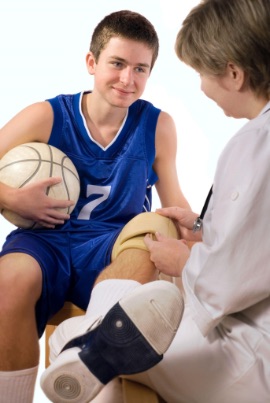 Sports injuries are common amongst both youth and adults. While they may not be completely preventable, there are ways to reduce the chances of acquiring an injury, such as training in body awareness and improving muscle tone. Managing these injuries requires a combination of both protecting the injured body part and optimizing healing.
Sports injuries are common amongst both youth and adults. While they may not be completely preventable, there are ways to reduce the chances of acquiring an injury, such as training in body awareness and improving muscle tone. Managing these injuries requires a combination of both protecting the injured body part and optimizing healing.
Sports are a terrific way to develop youth leadership, promote teamwork, and teach resilience. They also provide adults with a way to stay in shape and form comradery outside of work.
However, sports injuries are almost inevitable in both populations. They not only keep players from getting on the field, but they also set them up for issues in the future, such as early osteoarthritis.
Here, we’ll discuss the most common sports injuries, why they occur, and how you can manage or prevent them.
Every sport has a distinct set of common injuries depending on the type of motions frequently used and level of impact on the joints. Tennis, for instance, requires continuous repetition of swinging a racquet at fast speeds and a lot of quick side-to-side movements. Swinging incorrectly over time can cause a common injury called tennis elbow, or lateral epicondylitis, and poor lunge or running mechanics can lead to foot, ankle or knee sprains or strains.
The most common injuries in youth contact sports like football and soccer are bone breaks, ACL injuries, and concussions. In more endurance-geared sports like track and cross country, injuries such as stress fractures, plantar fasciitis, and shin splints are common. While some of these injuries occur strictly from overuse, many occur from preventable, or at least modifiable, factors.
Sports injuries are more prevalent now than ever, especially in children. While the competitiveness of youth sports has skyrocketed, the level of daily youth activity has plummeted. Today’s kids tend to be sedentary except while on the field. This leads to not only decreased cardiovascular fitness, but decreased muscle tone, body awareness, and neuromuscular control.
Teaching children proper mechanics with sport-specific skills, strength training, and stretching routines can help prevent injuries. Adults can also adopt proper tools and techniques to play sports safely when given the right training. Teaching athletes’ body awareness and neuromuscular control won’t eliminate injuries, but these tools can reduce them.
The best treatment for sports injuries is prevention. While the latter is not always possible, making policy changes can help. When a rule prohibiting body checks in youth hockey went into place, injuries went down by 50%. Officials are putting similar practices into American football and youth soccer as well.
When the unavoidable does occur, however, injury management has come a long way since the days of preaching RICE (Rest, Ice, Compression, Elevation). Rehabilitation professionals like physiotherapists have adopted the acronym PEACE and LOVE to treat sports injuries (Protection, Elevation, Avoid anti-inflammatories, Compression, Education, Load, Optimism, Vascularization, and Exercise). This approach allows the player to take a more active role earlier in their recovery and steers them in the right direction for treating their injury as it progresses.
Sports injuries are part of the game. They may not be completely preventable, but we can certainly try to minimize their prevalence and treat them properly. While they may keep athletes down for a short time, the payoff in the long term is worth it. To learn more about how to manage a sports injury, talk to your physiotherapist today!
References
1. Emery CA, Pasanen K. Current trends in sport injury prevention. Best Pract Res Clin Rheumatol. 2019;33(1):3-15. doi:10.1016/j.berh.2019.02.009
2. Lin CY, Casey E, Herman DC, Katz N, Tenforde AS. Sex Differences in Common Sports Injuries. PM R. 2018;10(10):1073-1082. doi:10.1016/j.pmrj.2018.03.008
3. Launay F. Sports-related overuse injuries in children. Orthop Traumatol Surg Res. 2015;101(1 Suppl):S139-S147. doi:10.1016/j.otsr.2014.06.030
4.Dubois B, Esculier JF. Soft-tissue injuries simply need PEACE and LOVE. Br J Sports Med. 2020;54(2):72-73. doi:10.1136/bjsports-2019-101253
